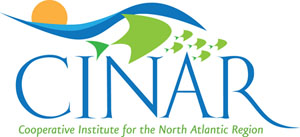They come up suddenly sometimes, with their distinctive V-shaped blow, lumbering in open-ocean brine like water-bound elephants. The North Atlantic right whale is a voluminous creature, a fact easily forgotten as often only their rostrum—upper jaw—is visible when they surface. So it might seem amazing that these huge creatures specialize in a specific, diminutive food source.
The spacing of their baleen is perfectly adapted to feeding on the copepod Calanus finmarchicus, a type of small planktonic ocean crustacean. Not only that, but multiple researchers have discovered right whales prefer a specific pre-adulthood life stage of Calanus which they search for with vigor within the confines of their feeding grounds in the Gulf of Maine.
 |
| Calanus finmarchicus. Credit: Nancy Copley at Woods Hole Oceanographic Institution |
This relationship is adeptly captured by the title of a chapter in the book The Urban Whale which describes current research on Northern right whales: “Enormous Carnivores, Microscopic Food, and a Restaurant That’s Hard to Find.” The book, published by Harvard University Press in 2007, subtitled: North Atlantic Right Whales at the Crossroads, was edited by contributors Scott Kraus and Rosalind Rolland.
Predator and prey are intimately connected in what is likely an ancient relationship. However, neither are static creatures and both experience a great deal of movement in their daily lives. Many marine organisms are mobile creatures, but in the lives of the Northern right whale and the copepod it so depends upon, their interspecies dance is a matter of life and death.
C. finmarchicus belongs to a group of tiny organisms collectively recognized as plankton. Plankton—the basis of marine life – is made up of single and multi-cellular species of animals, plants, bacteria, and viruses. Without their existence, the ocean would be a desolate, liquid abyss. Their body forms are beautifully diverse, displaying an array of spikes, plates, and other appendages.
In a planktonic universe, the life paths of the excruciatingly tiny are at the mercy of the currents, defined by large and small-scale ocean circulation patterns. Their very name is derived from the Greek word Planktos which means to passively wander or drift. They are the ocean’s miniscule hobos.
Calanus finmarchicus is a species of copepod that tends to dominate zooplankton—the animal component of plankton—biomass within the Gulf of Maine. Populations are pushed into the Gulf by the way of the Labrador current and follow the system of currents generally in a counterclockwise direction, all the while progressing through several life stages along the way. Multiple generations, or cohorts, of Calanus can enter the Gulf during a single season providing a continued food source for the whales that feed on them.
 |
| CV stage Calanus finmarchicus. Credit: Mark Baumgartner at Woods Hole Oceanographic Institution |
Recent work from a group of New England-based researchers focusing on Calanus movement specific to Cape Cod Bay found currents are highly variable annually, which affects where these copepods can be found from year to year.
Plankton are not absolutely encumbered by ocean movement, however, and can often maneuver on a smaller scale within their world. They are immersed in a constant struggle to find the sweet spot of conditions. The primary needs of C. finmarchicus and most other zooplankton tend to be governed by predator avoidance, search for prey, and reproductive needs.
These burdens may figure strongly in a fascinating behavior some populations of Calanus finmarchicus partake in with countless other members of the planktonic community known as diel vertical migration. Diel vertical migration is an intimate affair between the daylight and the depths. During the brightest hours of the day, some plankton (and occasionally larger organisms) will recess to darker ocean reaches, primarily in a bid to avoid predation. When the sun starts to dip low in the sky they begin traversing the distance to the sea surface, where food lies in wait. However, we understand poorly the cues that govern why plankton do or do not make this daily journey.
Calanus also experiences a behavior with longer temporal implications for both its own populace as well as its predators. The stage that right whales most prefer, according to multiple researchers, is one referred to as a copepidite V (CV)—pre-adulthood—stage. When in this phase, the petite crustaceans develop oil sacs that essentially transform the copepods into a calorie-laden, rich food source.
These oil sacs are meant to sustain C. finmarchicus during a period of dormancy known as “diapause” which they will enter into while undergoing their final transformation into fully-formed reproductive adults. Not all Calanus in this stage will enter diapause, but those that do sink many meters down and embrace a dark hibernation until some as yet undiscovered signal pulls them out of it into the final phases of their relatively short lives.
While Calanus is also essential in sustaining vital fisheries and feeding other organisms in the Gulf of Maine, the role they play in the lives of the North Atlantic Right Whale is unique. The Northern right whale has the sad distinction of being in the ranks of the most threatened cetacean species in the world. Their population was initially culled to dismal size by whaling, and by all estimates currently numbers no more than 300-400 individuals. These slow-moving mammals —usual ly traveling at no more than 3-4 mph, they are certainly not the cheetahs of the sea— live a life fraught with danger, with most threats arising from ship strikes, fishing-gear entanglement, and noise pollution.
During the late spring and summer months when their yearning for food reaches a frenzy, right whales slip into the Gulf to find copepods. Aerial and ship surveys that have followed these mysterious animals for the better part of three decades have identified major feeding grounds within the Gulf of Maine that include Cape Cod Bay, the Great South Channel, Roseway Basin, and The Bay of Fundy. However, Northern right whales do not have a strong sense of fidelity when it comes to historical feeding grounds and are involved in an unpredictable pattern of abandonment and re-visitation. They are answering the innate call to search out food, wherever it may be.
 |
| Credit: WHOI and NOAA NEFSC; photo taken under federal permit no. 775-1600 |
Research completed in the mid ’80s by Robert Kenney, a scientist at the University of Rhode Island, suggests right whales may need to consume in the range of 407, 000 – 4,140,000 calories per day, which equates to a whole lot of copepods—up to 2 billion. Because their food source is so small, the task is sometimes like looking for a needle in a very large, watery haystack.
Zooplankton, however, are not uniformly distributed in the water column and often form dense aggregations thought to be controlled by a mixture of physical and biological factors. Right whales will feed on thick strawberry-colored congregations of C. finmarchicus in surface waters by employing a behavior known as skim feeding, tilling through food like cetacean lawnmowers. Calanus often has a pinkish hue and when the animals are concentrated this color is intensified.
Researchers Mark Baumgartner of Woods Hole Oceanographic Institution and Bruce Mate of Oregon State’s Marine Mammal Institute used cleverly designed, suction cup-mounted, time-depth recorder (TDR) tags to track the underwater movement of right whales and found they also spend time feeding at depths that correlate with deep diapausing layers of CV stage Calanus.
How the whales find these patches is an enigma, but multiple ideas and hypotheses are being suggested within the scientific community. The mind-blowing part is to think about the many strategies that these mammals may need to use in response to the multiple temporal and spatial scales they encounter during their hunt. Finding the feeding grounds they will frequent for part of the season once in the Gulf may entail learning passed lovingly from mother to calf or sensing the signature of characteristic water masses in the region. Once there, locating the places zooplankton are likely to amass is still a daunting undertaking in such a large region and may involve what amounts to whale “spidey-senses”- detecting possible temperature, salinity, or chemical cues.
The lives of right whales are not entirely ruled by their necessary gluttony however. Females, bellies swollen, will migrate to southern waters between Georgia and Florida during winter months to give birth. This often times only accounts for 100 or so individuals and there has long been a veil of mystery associated with where the rest of these giant mammals are during that time. Through their aerial survey efforts, NOAA’s Northeast Fisheries Center researchers may have recently stumbled upon what may be a winter feeding and mating ground literally hidden in plain sight, located near Jordan Basin fewer than 100 miles south of Bar Harbor, Maine.
As yet, we can scarcely pretend to understand all the intermingled intricacies motivating a right whale, and these behemoths sometimes defy our expectations. Males and juvenile right whales that should be in colder, more productive waters feeding and mating during the winter are sometimes found in calving grounds.
Dianna Schulte, president and co-founder of the Blue Ocean Society for Marine Conservation has seen the phenomenon in her own survey work and keenly notes: “Yes, it does seem that food (copepods) dictates where right whales will be found, however this is certainly not always the case. We seem to think that we, as humans, know what is best for right whales, but right whales seem to occasionally have a different agenda.”
What a peculiar link between two utterly different creatures. One, an unwieldy giant fragile from the threat of extinction and the other a minute speck in an ocean full of them, but both at the mercy of the physical and biological throes of mother nature. It is an interconnection we can only hope to watch for years to come.
Online Resources:
New England Aquarium Right Whale Aerial Survey Blog
New England Aquarium Right Whale Bay of Fundy Blog
Blog Entry Describing the Ecosystem Modeling Lab’s Intentions to Model Calanus finmarchicus Diapause
Zooplankton diversity: a bizarre – and changing – array of life forms
North Atlantic Right Whale Consortium
What Can We Do to Ensure Healthful Habitats For Right Whales? – Article by Woods Hole Oceanographic Institution right whale research Mark Baumgartner



















